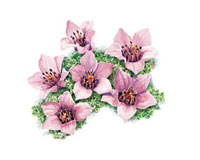Purple Saxifrage
A welcome sight to northerners, the Purple Saxifrage (Saxifraga oppositifolia) is one of the first plants to flower in the Arctic  spring. This plant most often grows in very rocky ground where no other plants seem able to grow. Small, with trailing leafy stems, the branches end in single flowers, which are often so crowded together that there appear to be many more than one on a stem. Called Aupilaktunnguat ("something like bold spots") in Inuktitut, the petals of the purple saxifrage are usually a vibrant purple colour, although a single white flower can occasionally be seen. Where many of the plants grow together across the tundra, they provide a vivid purple contrast to the snow that is often still present when they flower.
spring. This plant most often grows in very rocky ground where no other plants seem able to grow. Small, with trailing leafy stems, the branches end in single flowers, which are often so crowded together that there appear to be many more than one on a stem. Called Aupilaktunnguat ("something like bold spots") in Inuktitut, the petals of the purple saxifrage are usually a vibrant purple colour, although a single white flower can occasionally be seen. Where many of the plants grow together across the tundra, they provide a vivid purple contrast to the snow that is often still present when they flower.
The purple saxifrage plays a number of roles in Northern culture. The full blooming of the flowers indicated the time of year when young caribou are being born out on the land. The flowers of the purple saxifrage have a sweet taste and are eaten especially in communities where berries are not abundant. When eaten, the flowers can help relieve gastric problems, but, as with all herbal remedies, if eaten in excess can cause complications. The stems and leaves can be used to make tea. According to many Nunavummuit, the tea is best later in the season after the flowers have died. In times when tobacco was a valued commodity, the stems and leaves were often added to store-bought tobacco. As one of Nunavut's hardiest and most reliable plants, it is fitting that the purple saxifrage has been chosen as its Floral Emblem.
